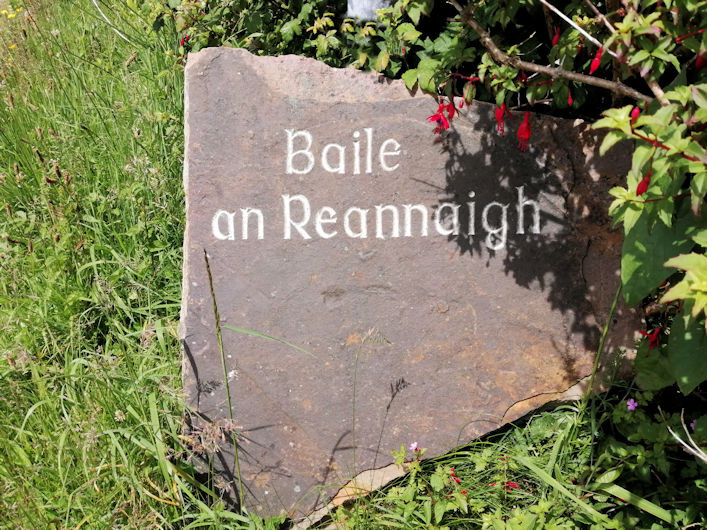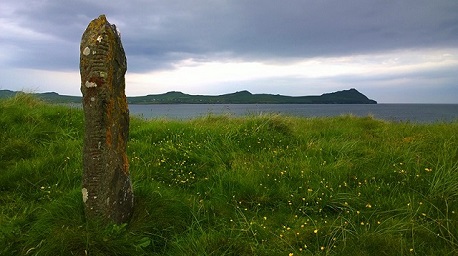
Type: Ogham Stone, Burial ground and probable ecclesiastical site.
Townland: Cill Mhic Uíleáin

Exposed by a storm at the end of the 18th century, along with 6 other ogham stones (Cuppage 1986, 250). Townland of Ballinrannig and barony of Corkaguiney. (GPS coordinates -10.388106, 52.178511)
Original:
Find location probably original site.
Last Recorded:
Re-erected on the knoll, at or near the original site.
Monument'Cillvickillane/Cill Mhic Uíleáin:
A large, grass-grown, sandy knoll, crowned by [this] single ogham stone, is located at the base of a small promontory on the S shore of Smerwick Harbour.
It was here that a storm at the end of the 18th century exposed 7 ogham stones, a possible fragment of an ogham stone, a cross-inscribed stone, a number of graves and quantities of bone, and the ruins of several houses (Windele 1838, 145; Chatterton 1839, 190).
Windele's sketch of the site shows the ogham stones set out in a rough semi-circle on top of the mound with a slab-lined grave positioned nearby.
Chatterton describes the houses as being beyond the mound nearer the sea. Windele interpreted these as the remains of an ancient village, but it has also been suggested that one of the structures, roughly 20 feet x 12 feet (6 x 3.7m), was a church (Curran no. 21).
Lord Ventry removed 6 of the ogham stones from the site in the mid-19th century; nos. 1 to 4 now line the driveway to
Burnham House/Colaiste Íde, between Dingle and Ventry, and nos. 5 and 6 are preserved in the grounds of
Chute Hall near Tralee. Only no.7 is still preserved on the original site'
(Cuppage 1986, 250-2).
'Grit', 1.73m x 0.51m x 0.18m (Converted from Macalister 1945, 149).
Damaged at the top of the stone and on the right-hand angle.
'Inscription pocked and rubbed on two angles of the eastern face
(up-down): in good condition except that the last name had been
chipped away, all but the final S' (Macalister 1945, 149).
The letters
in square brackets [I MUCCOI DOVVINIA] have been hypothetically
restored by Macalister.
CUNAMAQQI CORBBI MAQQ[I MUCCOI DOVVINIA]S.
Translation'of Conmac of Corb son of [the descendants of Duibne]?'
CommentaryThis is one of the inscriptions listed by McManus (1991, 93-4)
to be among the earliest in the corpus showing no trace of vowel
affection. It may be dated to the first half, or the early second
half, of the fifth century (McManus 1991, 97).
Here we have one of very few examples were parentage/lineage is
indicated through the use of the possessive genitive (CUNAMAQQI
CORBBI 'of Conmac [son] of Corb'), rather than through use of the
word MAQQI 'son' or AVI 'grandson, descendant' (cf. CIIC 162 CUNAMAQQI
AVI CORBBI at Ballintaggart).
McManus also notes that 'it may be
significant that several of the instances of the omission of the
word for 'son' occur before or after the name element MAQ(Q)I-,
-MAQ(Q)I' (McManus 1991, 51, 171 n. 12).
First recorded by Vallancey (1804) in Collectanea de Rebus Hibernicis 6, 226 (Macalister 1945, 144). This stone was recorded for the Ogham in 3D project in the Summer of 2016 by Emmy Van Den Berg, a participant on the Corca Dhuibhne 3d project, using Structure from Motion 3d technology.
ReferencesCuppage/etal/1986, 250: 'A large
grass-grown, sandy knoll, crowned with a single ogham stone, is
located at the base of a small promontory on the S shore of Smerwick
Harbour'.
Macalister/1945, 144: 'In 1782 a storm
blew away an accumulation of sand, and revealed a series of seven
Ogham-inscribed stones, in an ancient burial-ground, called Kilvickillane,
on the shore of Smerwick Bay'.
Emmy Van Den Berg
Photo courtesy of Helene Brennan